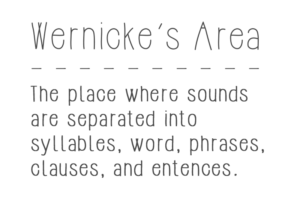The Connection Between Brain and Language Abilities

What is the connection between the brain and one’s language abilities?
Language is one of the most important things in a child’s development. When you speak, the language areas of the brain are stimulated.
So, how does the brain create and understand language?
The Process
 When there is an auditory verbal input, the sound is received by the
When there is an auditory verbal input, the sound is received by the temporal lobes, especially by the primary auditory cortex. After receiving the signals, they are processed and sent to Wernicke’s area to be interpreted.
After comprehending its meaning, there are two possibilities:
1. If there is no need for a response, the verbal input will be stored in memory. When needed, it will be retrieved and used.
2. If the input needs verbal response, the interpretation of the signals will be sent to Broca’s area through arcuate fasciculus. In Broca’s area, the process of responding is started.
After it’s decided how the response will sound like, the Broca’s will command motor cortex to follow through. The process inside the motor cortex is not simple either.
For a statement, there is a minimum of 100 muscles and 140.000 neuromuscular involved. Motor cortex has to decide the order of words and sounds, as well as the order of sound features in the response.
What about if the input is written?
If the input is not auditory but written, the brain process is different.
The input is not sent to the primary auditory cortex, but to visual cortex in the occipital lobes instead. This input is not directed to Wernicke’s right away, but it will go through angular gyrus which coordinates comprehension of the occipital region.
After this step, the same process happens, where it is sent to Wernicke’s and Broca’s for verbal response. When the response is visual, then the information will be sent to the parietal lobes for visualisation.
What does this mean?
The processes above have shown that different parts of the brain are needed to work optimally in order for someone to perform their language abilities well. When someone’s having difficulties in speaking, listening, writing or reading, it could mean that a part of their brain is not in an optimal condition. To find out, an assessment using EEG is required. Following the assessment, the specific parts of the brain can be trained to achieve the optimal condition.
4 Tips to Enhance the Love of Reading
You're on Brain Optimax's Learning Site Go to Brain Optimax's Main Site → Reading is very important in our school-age children’s lives. Even though it is involved in every subject, many children struggle to love it, some even hates the activity. How to get our...
Tips about Child’s Learning Styles [INFOGRAPHIC]
A child’s learning styles can be categorised intro three types, which are visual, auditory, and kinesthetic. Do you already know which learning style is the best for your child? Want to know how to …
My Kids Won’t Listen to Me: What to Do?
Children usually hear only what they want to hear. It is the same case with teenagers, as they are more likely to listen to their peers compared to their parents. Here are some tips to make them listen:


![Tips about Child’s Learning Styles [INFOGRAPHIC]](https://brainoptimax.com/wp-content/uploads/2016/12/article-learningstyles-banner-400x250.jpg)




0 Comments